HMS Ben My Chree
British Seaplane Tender

AJM Models No. 700-041,
1/700th Scale Cast Resin
Reviewed by Devin Poore, July 2024
|
| HMS Ben-my-Chree (which means "the woman of my heart"
in Gaelic), started life as a civilian packet steamer. Built in 1907, she
served in her civilian role until chartered by the Royal Navy in 1915.
During her conversion to a seaplane tender, a large section of her aft
superstructure was removed, replaced by a hangar. Her compliment of six
seaplanes were hoisted on and off the ship with heavy cranes for take-off
and landing. A flying-off platform was also installed over the bow, complete
with a trolley and rail system that allowed smaller seaplanes to launch
directly from the ship.
Initially stationed with the Harwich Force in coastal England, she participated
in several attempted air strikes on German naval forces that had to be
aborted due to bad weather. Eventually Ben-my-Chree transferred
to the Dardanelles, where her aircraft provided spotting information for
ships engaged in gun support for troops ashore. Her air group also undertook
several torpedo attacks on enemy ships.
Dispatched to the Greek island of Kastellorizo, on January 11th, 1917,
to aid French troops harassed by Turkish artillery, she came under fire
from a hidden enemy battery only hours after her arrival. The gunners quickly
found the range on Ben-my-Chree, hitting her multiple times, disabling
her steering, and starting fires. She sank in shallow water five hours
later, with no loss of life. In 1920 her wreck was recovered, but was so
damaged she was written off, and towed to Venice for scrapping. |
Photo snagged from the Ben
My Chree Wikipedia article.
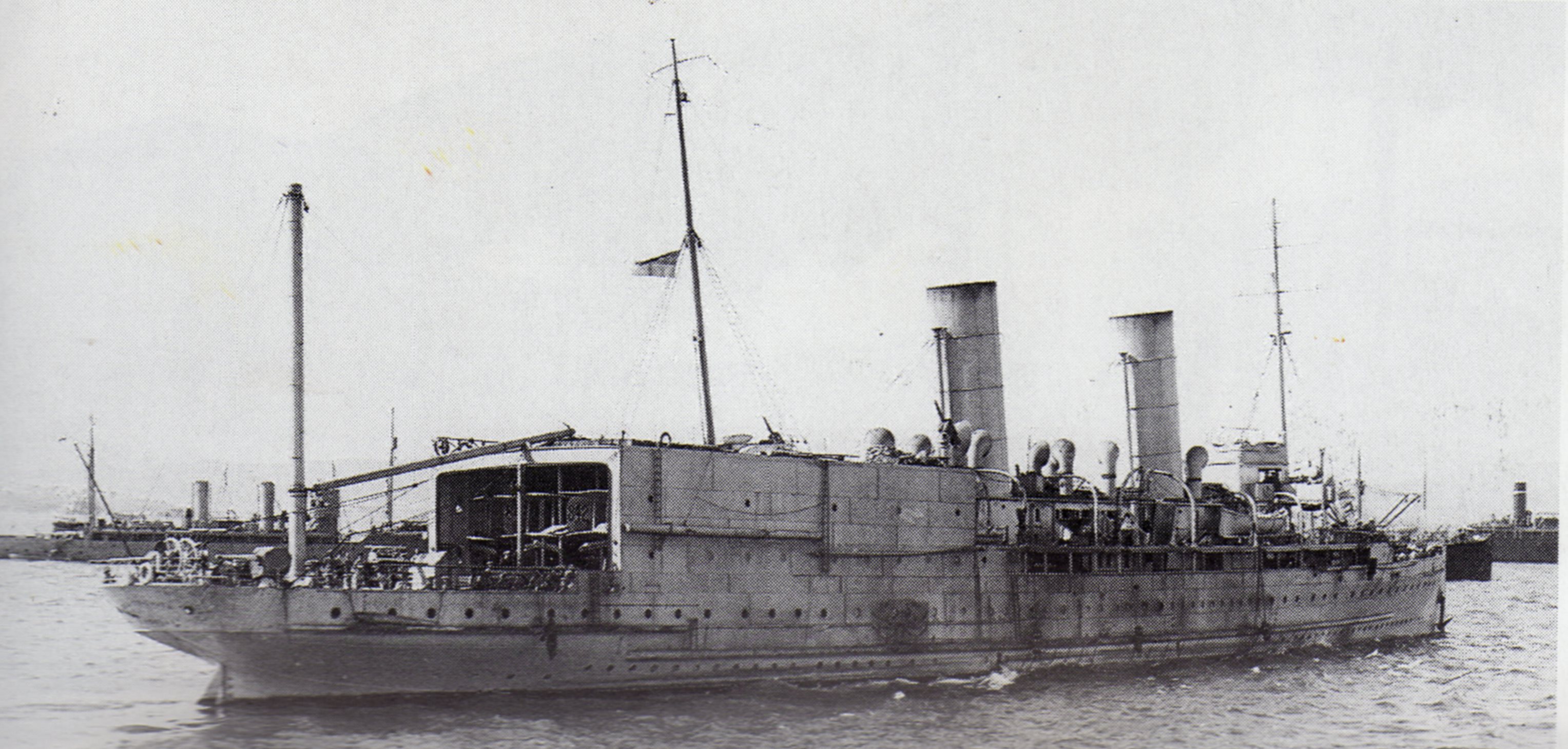
|
| HULL |
| The hull is one piece, and looks to be cast using an open-face
mold. There's a slight bit of overpour around the edge of the waterline,
but very minimal that'll disappear with a little flush sanding. Portholes
are nicely rendered and in straight lines, with just a few of them needing
a twist from a drill bit to sharpen their edges. Decks show subtle scribed
detail, wood planking forward and aft, including inside the hangar. Locator
pads on the bow show where to place the provided winch, hawse pipe openings,
etc. There are several deck house structures cast as part of the hull.
In a few spots where these structures meet the decks there are small bits
of excess resin that will need to be scraped away, but other than that
and air bubbles on the very bottom of the hull - where they'll never be
seen - there are no other defects in the hull. In the photos you can just
make out a gap amidships when the hull sits on a flat surface, but that's
due to the previously mentioned overpour. This will disappear as soon as
the hull bottom is sanded flat.
Based upon a few sources I found online, Ben-my-Chree measured
from 116 meters to 130 meters (390 feet) in length, depending on the source,
and 14 meters (46 feet) in beam. Overall length of the hull comes in at
6.55", which is a little short (by 1/8") if you go by the longest measurement,
but much closer if you take the shorter measurement. The beam measures
spot-on at .79". |
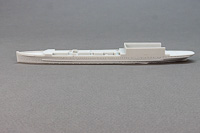
|
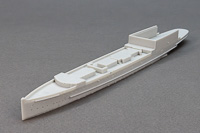 |
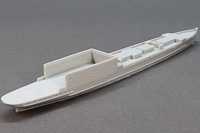 |
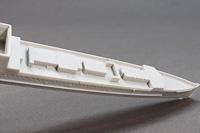 |
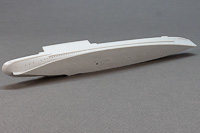 |
 |
 |
| SUPERSTRUCTURE RESIN
PARTS |
| A flat casting wafer contains the 01 level deck, the hangar
roof, the bridge deck, and the two bridge structures. These are cast thin
and flat, but the small resin blob are present again where the parts meet
the casting wafer. As the wafer needs to be flush-sanded away, though,
these won't be an issue. The 01 level deck shows the same fine planking
detail as the hull. The 01 level superstructure is another separate piece.
It has a major casting plug on the bottom which will require careful removal,
but otherwise the door detail is good, as is the window pane detail on
the skylight. My copy has a couple of flecks of darker material in the
resin, but a little prodding show's it's merely that, discoloration, and
not voids or pinholes.
The stacks are particularly well done. The steam pipes and banding on
their exteriors are sharply rendered. The stacks are hollow to a depth
of .080" (2.2mm), so those wishing to have truly hollow stacks will need
to drill them out, but for most, painting the interior black or another
dark color will suffice. |
 |
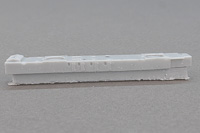 |
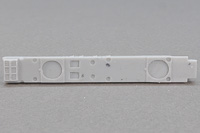 |
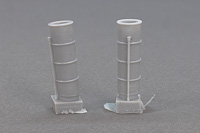 |
| RESIN SHIP PARTS |
| Ship's fittings come mostly on a long, doubled, casting
gate. Gun pedestals, mooring bitts, capstans, hawse pipe openings, and
other small components make up this, the longest of the gates. The other
smaller gates contain the other business items of the ship: anchors, searchlights,
vents, and the gun mounts. All of these cast details are finely rendered
with little to complain about. One of the searchlights in my example has
a slight casting defect in the lens, but it's a small blemish. Otherwise,
there are no air bubbles or other defects in any of the parts.
The ship's boats make up two other casting gates. The attachment between
the boats' hulls and gate are quite fine, as two boats had broken free
in my sample, but there was no damage at all. All boats show smooth hulls,
and sharp detail on interior seats. |
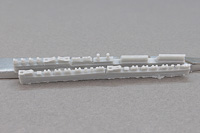
|
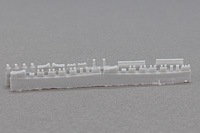 |
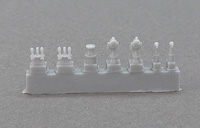 |
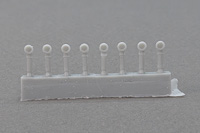 |
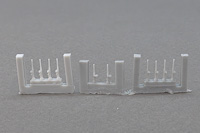 |
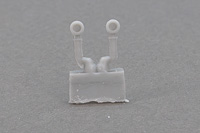 |
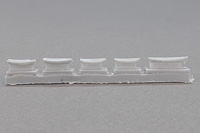 |
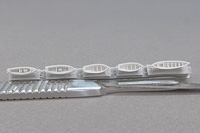 |
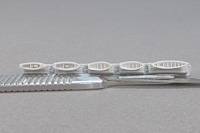 |
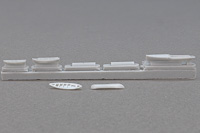 |
| RESIN AIRCRAFT PARTS |
| There are four different aircraft types included with the
kit: Short Type 184, Sopwith Schneider-Tabloid, Sopwith Baby, and the Sopwith
Type 860. The aircraft are made up of cast resin fuselage, floats, stabilizers
and wings, all on resin casting runners. They, like the boats, appear to
easily separate from the runners. These parts are thick enough to handle
without accidental breakage, but thin enough to convey some detail even
at this small scale: the wings of the Type 184 show rib detail. The instructions
show exploded-view drawings of the aircraft, which are made up of resin
and photoetch struts and props, therefore assembly should be straight-forward.
The Sopwith Baby fuselage components and one of the Type 184 wings have
some casting deformities in my sample, but nothing a little sanding stick
action won't rectify (clean up the small components before removing from
the casting gates), but the other pieces are very clean and sharp. Even
though the parts are clean, these aircraft are going to be fiddly to assemble.
In my opinion, I think they'll be the most challenging aspect of the entire
kit, but they should look great once finished. |
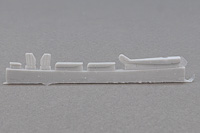 |
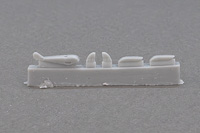 |
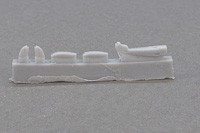 |
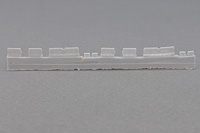 |
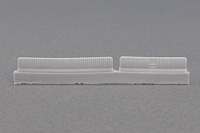 |
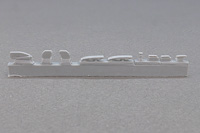 |
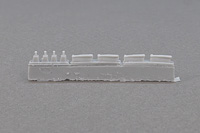 |
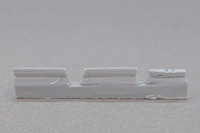 |
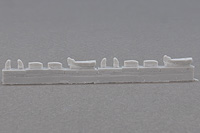 |
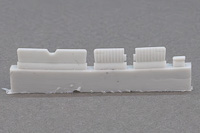 |
| INSTRUCTIONS |
| The instructions, printed on 8.5" x 11" letter-size paper,
are mostly black and white, but items such as the cover sheet and the camouflage
design are in color. A parts map shows each sprue casting gate and attached
parts, annotated by numbers which are called out in the assembly steps.
The diagrams are clearly drawn, denoting the differences between resin,
brass, and self-made parts by the style of part number (brass part numbers
are in rectangular boxes, resin in oval, etc). The cranes and masts are
made by the modeler with supplied brass wire, the length and diameter of
the wire for each assembly called out in the corresponding step.
One sheet of the instructions is devoted to the air group. The parts
required for each of the four types of planes are indicated, assembly steps,
painting guide, and decal placement all shown clearly. The final two pages
of the instructions are the paint guide, drawn larger than scale, showing
port and starboard profiles, and an overhead plan. All four vertical sides
of the bridge are also shown separately, to better illustrate the unique
blue and white camouflage Ben-my-Chree carried. Paint recommendations
are given in Lifecolor product numbers. |
 |
 |
 |
 |
 |
|
 |
| PHOTO ETCHED BRASS AND
DECALS |
| The photoetch is only .010" thick, so care will
be needed when handling it. Typical item such as railings, ladders, chains,
etc are included, but also ship-specific components like supports for the
flying-off platform, structural supports for the hangar, and tracks for
aircraft handling dollies, etc. Separate, smaller sheets of photoetch are
included for the aircraft, which consists of mostly struts and propellers.
The decal sheet is tiny, less than 2" across. Consisting mostly of markings
for the aircraft, including roundels and tail stripes. There are also ensigns
for the ship, and some Roman numeral markings that I assume are draft markings.
Colors all appear to be in register. |
 |
 |
 |
 |
| CONCLUSIONS |
| I'm a sucker for weird ships, and Ben-my-Chree definitely
qualifies in my eyes. The major components of the kit are well-cast, straight,
and detailed. While the parts are small, and a couple of them will require
some extra clean-up here and there, there aren't a lot of parts compared
to a carrier or other capital ship in the scale, so this should make for
an enjoyable build. Beginners could have a little trouble with the extra-thin
photo etch and possibly the air group assembly, so I wouldn't recommend
this as a first resin kit. But a second or third resin kit? Sure.
For those into unique ship subject, which AJM Models excels at, I recommend
this kit. Thank you to AJM Models for this review sample. You can find
their kits online at various retailers, which are linked at their website
via their logo to the right. |

|

© ModelWarships.com
|












































